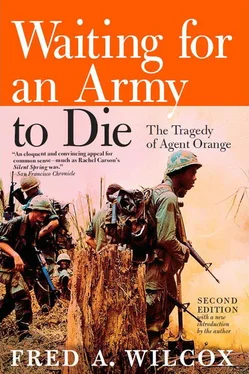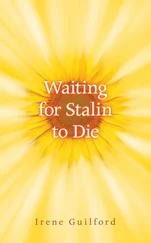According to the new article, the VA is offering “Agent Orange examinations” and Strait decides to visit the VA medical clinic. There he is given a four-page questionnaire asking for the time, date, place , and amount of his exposure to Agent Orange. Strait finds the questions peculiar and perplexing. In Vietnam he paid little attention to the spraying, and ten years later it seems ludicrous that he should be asked to remember such details. Although he can vividly recall being in defoliated zones, he did not keep a log of his entry and exit from such areas. “We were fighting a war,” says Strait, “not conducting an archeological expedition. It just never really occurred to us that it mattered.” Nor was it the Army’s policy to tell its troops how recently an area had been sprayed or how much dioxin they might ingest if they drank the water or ate food contaminated with Agent Orange. How much was he exposed to? That’s precisely what Strait wants the VA to tell him.
An hour passes before a physician enters the examining room and, after “poking and prodding” Strait for a few minutes, he explains that he has “received special training in these Agent Orange cases” and can assure the former paratrooper that “Agent Orange and dioxin have never hurt anyone, are not hurting and never will hurt anyone.” After briefly examining Strait’s complete questionnaire, the physician informs him that his headaches are “obviously due to war-related stress” and recommends that he pay a visit to the clinic’s psychologist. A consultation with the hospital’s dietician, says the doctor, will undoubtedly help Strait’s skin rash.
Strait is surprised, even angry. What word has he used, he asks, himself, that the man doesn’t understand? Did he not just explain that he is working at a steady job, does not drink excessively or take drugs, and does not feel he is suffering from “post-Vietnam syndrome?” Realizing that his efforts to persuade Strait to see a psychiatrist are futile, the doctor says that he will make an appointment for him to see a dermatologist. Meanwhile, he tells Strait, “My advice to you is that you go home and stop worrying about all this Agent Orange stuff.”
During the following weeks the Straits wait anxiously for the results of Jerry’s blood and urine analysis; but when weeks, months, and finally a year pass without notice from the clinic, they conclude that they will never hear from the VA again. Two years and three months later, Sandy is astonished to discover a pamphlet in the mail from the VA’s Washington headquarters. “We could hardly believe our eyes after all this time,” she explains. “On the outside it said, ‘WORRIED ABOUT AGENT ORANGE?’ And on the inside there is a picture of Max Cleland and he is saying, ‘Oh heavens, don’t worry about anything like that. Agent Orange never did anybody any real harm.’ I guess they think we’re pretty dumb, because Jerry and I know that Cleland has not been the VA’s director for some time. Why they’re still sending his picture around is a mystery to me.”
Although no one knows—because no government agency has bothered to count—how many children fathered by Vietnam veterans have suffered birth defects similar to those seen in the offspring of female laboratory animals exposed to dioxin, everyone agrees that this is one of the most volatile aspects of the Agent Orange issue. To parents of children like Lori Strait, the question of whether dioxin damages the chromosomes or sperm cells of exposed males should have been answered “before one drop” of Agent Orange was used in Vietnam. Yet two decades after the first defoliation mission was flown, there is still no unanimity among scientists on whether TCDD acts as a mutagen in male laboratory animals or in human beings. Citing a study of male mice treated with agent Orange, the VA continues to argue in its public relations pamphlets that “there is no medical evidence that exposure to Agent Orange has caused birth defects in the children of Vietnam veterans.” 1But according to attorneys for Vietnam veterans involved in the class action suit, “At least 2,000 children may be born with catastrophic deformities due to the chemical poisons their fathers carried home from the war.” 2In addition, the VA’s pamphlets fail to mention that TCDD-dioxin is a depressant of spermatogenesis in male rats, and causes mutations in salmonella and drosophila. 3
Evidence of the possible mutagenic effects of TCDD on exposed males is not limited to bacteria or laboratory rats. In Vietnam, Dr. Ton That Tung and his colleagues have been studying the possible effects of dioxin on North Vietnamese soldiers exposed to herbicides while serving in the South. Among the birth defects Dr. Tung and his colleagues have observed are cleft lips, shortened limbs, absence of nose and eyes, malformed ears, clubfeet, absence of forearm, hydrocephaly (water on the brain) and anencephaly (a condition in which all or a major part of the brain is missing), and a variety of heart problems.
Because Dr. Tung was aware that laboratory research had already proven dioxin teratogenic and fetotoxic in rats and mice, he was careful to inquire whether the wives of former North Vietnamese soldiers had been exposed to herbicides. Through interviews with the veterans and their families, Tung’s research teams learned that none of the women who had given birth to deformed children had been exposed to herbicides; yet in one district where the researchers found a total of nine birth deformed children were fathered by veterans. In another district, where veterans comprised only a small percentage of the population, Dr. Tung found that half of the deformed children born during a four-year period were fathered by veterans. Six out of the thirty children born with defects were anencephalic, and all six were fathered by veterans.
Statistically, writes Dr. Tung, his findings are extraordinary: In the region he was studying there should have been “one anencephalia in every 2,777 births, whereas we have one anencephalia per 197.7 births among veterans from the south. Furthermore, we must emphasize the great number of cardiac deformities: fifteen cases out of forty-three defects: i.e. 34.8 percent of the defects. The involvement of the neural tube seems to be in agreement with the studies of Barbara Field, who proved that in Australia there is a linear relationship between the rising rate of spina bifida [a condition where the spine is improperly fused] in newborns in the first generation and the rate of 2,4,5-T utilized each year.” Dr. Tung has also found that the wives of exposed veterans have an abnormally high rate of miscarriages, premature births, and stillbirths, while an unusual number of the veterans suffer from sterility. The fathers of deformed children, writes Dr. Tung, exhibited “signs of direct contact with herbicide sprays in South Vietnam.” Concluding his paper, he states: “by comparing reproductive outcomes of Vietnamese soldiers exposed to Agent Orange and those who were not exposed, there appears to be an excess of birth defects in children of the exposed veterans. This suggests that dioxin may act as a mutagen and thus would represent the first example of teratogenic damage due to male exposure in humans.” 4
In 1967, Arthur W. Galston, a professor of botany at Yale, tried to warn the US against the continued unbridled use of herbicides in Vietnam. “We are too ignorant of the interplay of forces in ecological problems to know how far-reaching and how lasting will be the changes in ecology brought about by the widespread spraying of herbicides. The changes may include immediate harm to people in sprayed areas…” 5
Galston’s warning turned out to be prophetic. Just two years later, reports of birth defects in the offspring of Vietnamese women began appearing in Saigon newspapers, but the US government dismissed the peasants’ complaints as communist propaganda, arguing that there was no scientific proof that Agent Orange harmed human beings. Today the government’s response, through the Veterans Administration, remains essentially unchanged, in spite of the fact that Vietnam veterans have fathered hundreds and perhaps even thousands of seriously deformed children. At the New York State Temporary Commission of Dioxin Exposure hearings, a veteran testified that “before my son was ten and a half months old he had to have two operations because he had bilateral inguinal hernia, which means his scrotum didn’t close, and his intestine was where his scrotum was, and his scrotum was the size of a grapefruit. He also has deformed feet… My oldest daughter has a heart murmur and a bad heart. Once she becomes active, you can see her heart beat through her chest as though the chest cavity is not even there, as though you were looking at the heart.”
Читать дальше











